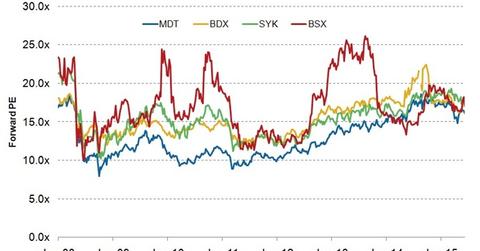How Is the US Medical Device Industry Valued?
The US medical device industry has rebounded sharply since its 2008 decline, and it is trading at a high PE of 21.9x.
Dec. 7 2015, Updated 2:04 a.m. ET

Valuation
The medical device industry is composed of a large number of growth-oriented small firms across different lifecycle stages as well as large market players. Also, some of the companies in the medical device industry are pure-plays, whereas a number of companies are conglomerates and combined drug-device businesses. Thus, it is crucial to determine the comparable peer companies for relative valuation in the medical device industry. Also, industry benchmarks and multiples used for the analysis should be based on a similar company peer group.
The forward price-to-earnings ratio is used for the valuation of companies in the medical device industry. It is calculated by dividing a company’s stock price by its earnings estimate for the next 12 months.
Major players
The US medical device industry has rebounded sharply since its 2008 decline, and it is trading at a high PE of 21.9x. Companies including Medtronic (MDT), Becton Dickinson (BDX), Boston Scientific (BSX), and Stryker (SYK) are trading at PE levels below the industry PE. Thus, these companies are undervalued. Strong pipelines of medical device products, a consolidation wave in the industry, and macro factors such as reduction in unemployment have led to an increase in investor confidence.
Becton Dickinson acquired Carefusion in 2014. The synergy from the acquisition will contribute to the revenues of the company through 2016. Medtronic has also made significant acquisitions and business model transformations in 2014-2015, which has helped it improve the already strong margins and market position. Also, Stryker seems to be undervalued in terms of PE ratio when compared to the industry average, but the lower revenues and stringent margins of the company make it comparatively less attractive.
Boston Scientific experienced fluctuating revenues and margins over the last few years. Low margins and weak revenues during 2010-2014 led to a higher PE ratio as compared to the industry average. The company’s cost-cutting measures and revenue growth in the recent years have led to significant improvement in the company’s performance and future prospects.
The iShares U.S. Medical Devices ETF (IHI) is one of the major ETFs that has exposure to the US medical device industry with Medtronic, Becton Dickinson, Boston Scientific, and Stryker having allocations of 14.8%, 5.5%, 4.6%, and 5.8%, respectively.
